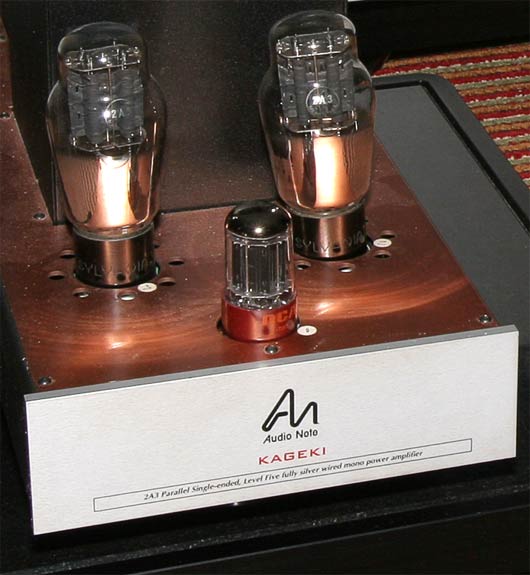[After this was written, I learned that the 4 ohm taps on the Kageki are located where the 8 ohm taps are on the Kegons. So, stupid story short, the description below is of the Kageki on the 4 ohm outputs. That therefore most likely means that the enhanced bass and decresed resolution had more to do with the using the 4 ohm instead of the 8 ohm outputs than it had to do with the difference between amps – BUT that the difference in emotion and dynamic swell will likely only be MORE different than reported here]
Been a very busy show for us. I am trying to get at least a photo or two of each room – and we are about 90% there. But even with help from our friends, the high amount of interest has kept me in our exhibit room quite a bit.
We did get to play junior Mixibitors this evening. We swapped out Audio Note Kegon amplifiers for the Audio Note Kageki amps next door for a long listen.

The old high-gain Kageki amps in our RMAF show system
The Kageki are 2A3 tube-based and about 7 to 8 watts in comparision to the 300B tube-based Kegons at 22 watts or so.
The Kageki have slightly richer harmonics and a slight ’tilt’ to the tonal signature in comparison to the more neutral Kegons.
The dynamic ‘swelling’ on the Kageki was more pronouced. The bass was also gripped slightly tighter in the mid-bass, but was not as controlling nor beefy in the lower bass.
Listening to the 2A3 Kageki was a somewhat more emotional experience, with perhaps a slight reduction in resolution as well. I also wonder if the separation on the Kageki was slightly better as well – but this may be because the bass on the active (self powered) Marten Coltrane Supreme loudspeakers was reduced a bit in comparision with the Kegons because we did not have time to dial it in – and the bass in this room is a little problematic, often negatively affecting the overhang and imaging and separation.

All in all the two amps were quite comparable in my opinion – but definitely different flavors…. So of course we want both! But.. not going to happen any time soon, unfortunately. Reason must prevail… right?
Last I looked the Kegons are at about $50K and the Kageki at $40K.
Anyway, those darn Mixibitors did not get to have ALL the fun this show…. 🙂







